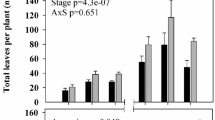Abstract
In subterranean clover, leaf size contributes to plant competitivity; besides, this trait is attributed a diagnostic relevance. The study assessed leaf size variation at two growth stages (60 days after sowing and flowering date) on genotypes belonging to the three main subspecies of the complex, viz. subsp. subterraneum, brachycalycinum, and yanninicum. After 60 days, brachycalycinum showed the largest leaflet area while subterraneum and yanninicum did not differ. Leaf size increase between the two measurements, remarkable in all subspecies, was significantly highest in yanninicum, which showed the largest area at flowering date. The leaflet length/breadth ratio was similar in the three subspecies at both stages. In subterraneum and brachycalycinum this ratio decreased significantly from the first to the second measurement; leaflet area increase seemed depending more on breadth than length increase. Yanninicum showed the longest petiole at flowering, and subspecies ranking for this character paralleled that of leaflet area. Particularly in subterraneum, there was a noticeable genotype variation for all characters. Earlier genotypes tended to have larger leaves after 60 days, and shorter petioles and smaller leaves at flowering date. In subterraneum, the genotype leaflet size decreased on increasing altitude and rainfall, and decreasing temperature of the collection sites. The leaf characters examined fairly confirmed to bear a taxonomic basis. Further assessing the physiological behaviour, particularly the response to defoliation and its agronomic implications, of genotypes characterised by different leaf size is envisageable.
Similar content being viewed by others
References
Cocks, P.S., A.D. Craig & R.V. Kenyon, 1982. Evolution of subterranean clover in South Australia. II. Change in genetic composition of amixed population after 19 years' grazing on a commercial farm. Aust. J. Agric. Res. 33: 679–695.
Francis, C.M., A.C. Devitt & P. Steele, 1974. Influence of flooding on the alcohol dehydrogenase activity of roots of Trifolium subterraneum L. Aust. J. Plant Physiol. 1: 9–13
Gladstones, J.S., 1967. Naturalized subterranean clover strains in Western Australia: a preliminary agronomic examination. Aust. J. Agric. Res. 18: 713–731.
Gladstones, J.S. & W.J. Collins, 1984. Naturalized subterranean clover strains of Western Australia. Technical Bullettin No. 64. Western Australian Department of Agriculture, Perth.
Katznelson, J., 1974. Biological flora of Israel. 5. The subterranean clovers of Trifolium subsect. Calycomorphum Katzn. Trifolium subterraneum L. (sensu lato). Isr. J. Bot. 23: 69–108.
Katznelson, J. & F.H.W. Morley, 1965. A taxonomic revision of Trifolium sect. calycomorphum (Presl.) Griseb. I. The geotropic species. Isr. J. Bot. 14: 112–134.
Pardini, A., 1992. Ecofisiologia del trifoglio sotterraneo (Trifolium subterraneum L., Trifolium brachycalycinum Katzn. e Morley). I. Effetti del pascolamento sulla densit'a, sulla crescita e sulla produzione di sostanza secca. Riv. di Agron. 26: 287–294.
Pecetti, L. & E. Piano, 1993. Influence of the environment of origin on early dry matter yield and plant morphology in subterranean clover. In: Management of Mediterranean Shrublands and Related Forage Resources, pp. 20–23. REUR Technical Series 28, FAO, Rome.
Piano, E., 1984. Preliminary observations on the structure and variability of Sardinian populations of subterranean clover. Genet. Agr. 38: 75–90.
Piano, E. & L. PECETTI, 1996. Selecting subterranean clover varieties for Mediterranean environments of Italy. In: G. Parente, J. Frame & S. Orsi (Eds). Grassland and Land Use Systems. Proc. 16th EGF Meeting, pp. 283–286. ERSA, Gorizia, Italy.
Piano, E., M. Sardara & S. Pusceddu, 1982. Observations on the distribution and ecology of subterranean clover and other annual legumes in Sardinia. Riv. di Agron. 16: 273–283.
Piano, E., L. Pecetti & A.M. Carroni, 1996. Climatic adaptation in subterranean clover populations. Euphytica 92: 39–44.
Rossiter, R.C. & W.J. Collins, 1980. The responses to defoliation of two strains of subterranean clover differing in growth habit when grown in swards. Aust. J. Agric. Res. 31: 77–87.
Author information
Authors and Affiliations
Rights and permissions
About this article
Cite this article
Pecetti, L., Piano, E. Leaf size variation in subterranean clover (Trifolium subterraneum L. sensu lato). Genetic Resources and Crop Evolution 45, 161–165 (1998). https://doi.org/10.1023/A:1008616706588
Issue Date:
DOI: https://doi.org/10.1023/A:1008616706588




